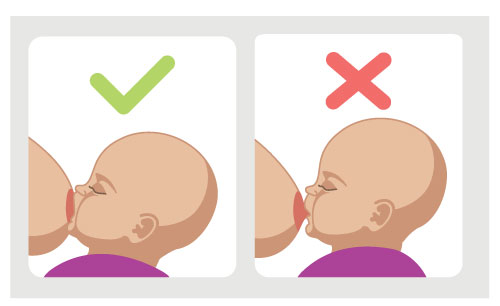Get in a comfortable chair with great back support to feed your baby. Check out Bas Ruttens Liver Shot on MMA Surge.
 How To Achieve A Proper Breastfeeding Latch Birth Song Botanicals Co
How To Achieve A Proper Breastfeeding Latch Birth Song Botanicals Co
A step-by-step guide to getting a pain-free latch.

Proper latching for breastfeeding. Without a proper latch your baby will not get the milk she needs and your breasts wont be stimulated to produce more initiating a vicious cycle of poor milk demand and poor milk supply. For more information about getting a good latch or breastfeeding holds call the OWH Helpline at 1-800-994-9662 or check out the following resources from other organizations. Use your breastfeeding support pillow if you have one.
With photos Breastfeeding Videos by Dr. Positioning and Latch-On by Andrea Eastman MA CCE IBCLC This is a longish article written for breastfeeding counselors that has some nice descriptions of latching and positioning along with info on. Guide your baby by bringing your breast close to hisher mouth.
Diagnose any underlying nipple condition and take appropriate treatment In cases of severely traumatized nipples temporary cessation of breastfeeding to allow for healing. Touch your nipple gently against his upper lip to encourage him to open his mouth wide. Ensure proper positioning technique and relief with adjusted latch-on.
Try your best to center your nipple for proper latching. You also might need to release her latch if she falls asleep on your breast. Many breastfeeding problems though can be avoided or improved with some simple tips and hands-on help with latching on.
Always bring your baby to the breast and let them latch themselves. Encourage your baby to open his mouth. Bring your baby to your breast.
If it continues after this break the suction by placing a finger between your babys lip and your skin. How To Achieve Proper Breastfeeding Latch. If latching hurts try again If the latch is painful or seems incorrect gently slide a clean finger into the side of your babys mouth and between her gums.
Animation illustrating assymetrical latch technique by Victoria Nesterova Nice animation text is in Russian The Mother-Baby Dance. Proper Deep Latch Comfortable and Effective We know that a latch is effective if the baby is making his adequate number of diapers for his day of life he is gaining five to seven ounces a week he nurses eight to 12 times per 24 hours and he seems satisfied after breastfeeding. For a proper breastfeeding latch you will need to place four fingers under the breast while presenting your nipple to your baby.
Remember that a little discomfort is normal when your baby is first latching to your breast. Make sure your babys chin isnt tucked into their chest. Your baby should lead into the breast chin first and then latch onto your breast.
We know a latch is comfortable if it feels like a strong tug not a pinch and not toe-curling pain. The following techniques plus proper positioning can help ensure a good latch. Hold your baby close your nipple level with his nose.
Signs of a Good Breastfeeding Latch If your baby is latching on to more than just your nipple you probably have a good latch. Aim your nipple just above your babys top lip. 5 Your child should be latching on to your entire nipple plus some of the surrounding areola the darker area of your breast that surrounds your nipple.
These breastfeeding latch tips will help you to get that perfect latch and on your way to breastfeeding for as long as you and your baby would like. Your baby needs to get a big mouthful of breast. Breastfeeding Information from the Centers for Disease Control and Prevention.
Aim your babys lower lip away from the base of your nipple. Latching is a very important part of breastfeeding both for mother and baby. Avoid leaning your breast forward into your babys mouth as this can lead to poor attachment.
Check if your babys lips are flanged out like fish lips. Remove your baby from your breast and try for a better latch. Using a stool to rest your feet on will help with good posture and prevent you from straining your neck and shoulders.
Latching on is the way your baby takes your nipple and areola into her mouth to suckle. Hold your breast with your hand so that your nipple is accessible to your baby to latch on. The latch is the point where your baby puts hisher mouth on your nipple in order to ingest milk.
Taking some time to ensure that your baby is latching on well is the number one most important thing that you can do as you are beginning your breastfeeding journey but is also one of the top breastfeeding problems. It is absolutely the most important aspect of breastfeeding. The wider his mouth is the easier it will be to get a good latch on.
HttpbitlyMMASurgeEp1Justine Bateman is an American actress writer and producer best known for her role. A Perfect Latch Physicians and other health professionals who care for infants frequently feel the pressure of time when faced with a mother who is having difficulty with breastfeeding. Placing your baby with their nose level with your nipple will encourage them to open their mouth wide and attach to the breast well.
This will break the suction so you can reposition your baby and try again. The fingers should be positioned behind your areola so your baby will be able to latch correctly. Babys lips should be turned outward like a fish.
Before you bottle-feed your baby its important to know how to clean and sterilise bottle-feeding equipment as well as how to prepare store and warm. Never prop up a formula bottle rather than holding it in your own hand.
 10 Common Bottle Feeding Problems And Solutions
10 Common Bottle Feeding Problems And Solutions
Proper Feeding of Orphans.
Proper bottle feeding position. One of the more traditional bottle-feeding positions cradle hold feeding consists of placing babys head in the crook of your arm and wrapping your hand around his bum. Bloating or aspiration of food. Dont feed her lying downformula can flow into the middle ear causing an infection.
Instead of lying down baby should be almost in a seated position with his head on your chest or in the crook of your arm. Youll need to tip it higher as the bottle slowly drains. If any of these occur examine the following aspects of your feeding methods.
You can try different ones to find out what works best for you. Breastfeeding is a skill that you and your baby learn together and it can take time to get used to. Cup your breast with your other hand placing your thumb above your nipple and areola at the spot where your babys nose will touch your breast.
How to do it. Always keep your babys head higher than the rest of the body during feeding. As with breastfeeding there are certain positions that will suit your baby better when they move on to bottle feeding.
In this bottle-feeding position babys head rests in the crook of your arm as you hold her head and chest at a slight inclineclose to your chest is great. Then lift your elbow so that baby is at a slight angle with their head higher than their body. This classic breastfeeding position requires you to cradle your babys head in the crook of your arm.
Your bottle-feeding position should mimic as closely as possible your breast-feeding position. Place your baby in a feeding position. If your baby cant always feed directly from your breast you might choose to bottle-feed with expressed breastmilkOr you might need to feed your baby infant formula which is the only safe alternative to breastmilk.
Cradle her in a semi-upright position and support her head. You can keep your baby in a breastfeeding position. Holding the baby and the bottle.
Sit in a chair with supportive armrests or on a bed with lots of pillows. Spoon-feeding baby solid foods usually begins at around 6 months old. If youre one of the estimated three quarters of American moms who has breastfed a baby you probably already know that transitioning to bottle feeding or.
Feeding position is an important matter for a newborn baby when they will be fed. Always tilt the bottle so the nipple is full of milk. Position the bottle at an angle rather than straight up and down so the milk only comes out when your baby sucks.
When it comes to feeding air in milk usually sends shivers up the spine of most parents and can lead to that most dreaded subject of colic. You can stand up and even walk around while feeding your baby in the crook of your arm. The effect of sucking habits cohort sex intercanine arch widths and breast or bottle feeding on posterior cross bite in Norwegian and Swedish 3-year-old children Am J Orthod Dentofac Orthop 1994106161-6.
Some people prefer tube-feeding because it is less time-consuming than bottle-feeding especially if a whole litter has to be fed. The puppy should not overextend its head during feeding. Its worth getting comfortable before a feed.
Position your baby so his head rests in the bend of your elbow of the arm on the side youll be breastfeeding with the hand on that side supporting the rest of the body. You also can keep your baby on your lap. Dont feed her lying down -- formula can flow into the middle ear causing an infection.
Here are three popular bottlefeeding positions to keep in your feeding toolkit. Place your baby in the crook of one arm. Work with your pediatrician to introduce new foods and discuss issues like spitting up or refusing foods.
Rest your feet on a stool or another raised surface to avoid leaning forward toward your baby. A quick tip for bottle feeding is to make sure the bottle isnt held too flat. Watch your baby for cues that he or she is full and then stop even if the bottle is not empty.
If necessary put a pillow on your lap to raise your baby up. Give your baby only breast milk or infant formula in a bottle. How to bottle feed.
Whether your breastfeed or bottle feed your baby making sure he or she gets the right amount of calories and proper nutrition is essential to proper development. So they dont want to eat more. Hold your baby close to you on your lap in a semi-upright position so you can make eye contact.
You just need to check the following points. Best Positions for Bottle Feeding To feed your baby cradle her in a semi-upright position and support her head. Let your baby take breaks from drinking when he or she seems to want them.
Lower position Ogaard B Larsson E Lindsten R. Hold your baby close when you feed him or her a bottle. Hold baby upright.
Support their head with your arm tilting their body. Warm the milk or water properly. If your baby doesnt remain correct position he or she will feel uncomfortable to eat.
The cradle hold is a crowd pleaser that many parents like to use because of the laid-back position for both parent and baby. There are lots of different positions you can use to breastfeed.